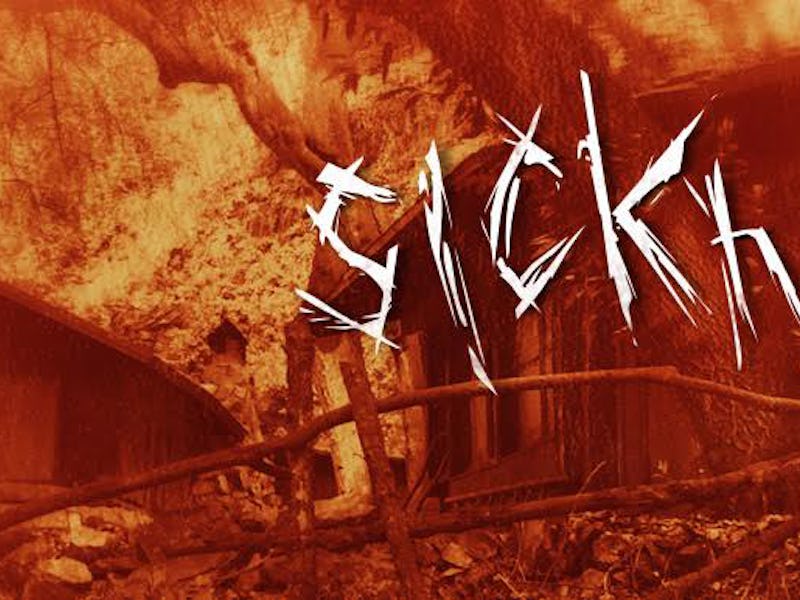Inside 'Sickhouse,' The 'Blair Witch'-Style First Feature Film Made On Snapchat
An entire feature film released on Snapchat, 'Sickhouse' turned storytelling (and the traditional filmmaking model) on its head.

It often takes years to write, produce, and distribute a movie — at least, of the traditional Hollywood variety. But at the tail end of April, Indigenous Media upended that model and stealth-released a feature film. On Snapchat.
Sickhouse is the first film to be made on Snapchat: scenes were distributed individually to followers’ mobile phones — and then slowly disappeared in reverse chronological order. The horror film follows YouTuber Andrea Russett, her “cousin” Taylor (who’s visiting Andrea and taking over her 500 follower-strong Snapchat) and Instagrammer Sean O’Donnell as they explore the legend behind Sickhouse — a small, secluded cabin in the woods. As you can imagine, things go south for the intrepid explorers pretty quickly.
“We loved this idea of coming up with something that would play as real, where the audiences are a little bit unsure of whether or not this is really happening,” executive producer Jake Avnet, who works at Indigenous Media, told Inverse. “A sort of nod to a film like The Blair Witch Project.”
A small crew shot and released the film in ten second clips over Snapchat, but it wasn’t just a matter of making a film and releasing it in Snapchat-sized segments. As a company that works in traditional storytelling platforms like film and television as well as new and emerging platforms like Snapchat, Indigenous Media wanted to make sure that the story fit the platform.
“The way that we like to look at it is that there’s a story for every screen,” says Avnet. “They’re usually not the same stories, but there is a great story that can be told on Snapchat, and there are certainly great stories that can be told in front of a television. And so that’s what motivates us, is the idea of telling these great stories.”
As one might imagine, creating a storytelling experience for Snapchat isn’t exactly an easy task. And even though the film was shot entirely on iPhones, the production wasn’t straightforward, either.
“This production was absolutely insane. It was done over five days. We shot the film in order, we released it in real time, so we were literally producing, distributing all at the exact same time. There was zero room for error here, and that was incredibly challenging.”
There were challenges with the script, too. Snapchat posts are limited to ten seconds, and trying to shoe-horn large paragraphs of dialogue into seconds-long posts doesn’t make for a very compelling viewer experience. So, because the film was built around the platform, the team behind Sickhouse loosened up a lot of the constraints that might be present on a traditional production.
“What we figured out pretty early was that we couldn’t have a real script,” says Avnet. “What we needed was a pretty detailed treatment and shot list.”
In addition to the shot list, the actors did a lot of improvisation, playing out character versions of themselves and building large parts of the performance on the fly. Knowing that Snapchat is a platform centered around authenticity, the Sickhouse team wanted to make sure that the film felt authentic and real.
“We were worried that if it was too scripted it would feel scripted,” says Avnet, “so we really tried to keep it as organic and loose as possible.”
Beyond the release itself, though, Indigenous created an entire social and internet ecosystem around the film leading up to the release. A website reminiscent of the internet’s Geocities days was created and filled out with the fictional mythology of Sickhouse. O’Donnell also posted an Instagram photo about getting out of LA for the weekend several days before the film began shooting and Andrea responded, planting early seeds for the film’s premise and believability.
The website in particular wasn’t just a matter of drawing up a quick one-page site with a few paragraphs of information — in order to create the believable experience that Indigenous was trying to create, everything had to fit aesthetically. It had to look real, because a big part of Sickhouse’s release was that it had to seem like it could be something that was really happening to Andrea, Sean, and Taylor.
Avnet says that making the website look bad enough was particularly challenging and required getting inside the mind of someone who might be managing a website dedicated to a pretty morbid, decades-old tale.
“We knew that if Andrea started talking about Sickhouse…that people would start asking, ‘What is Sickhouse?’” says Avnet. “And we wanted to make sure in order to make it feel as authentic as possible that when they start searching ’sickhouse’ whether its on Twitter or Google or whatever that there was something to find. And not only was it something, but it couldnt look too good.
These online efforts prior to the films simultaneous production and release weren’t just attempts at building hype, though. They actually functioned as a part of the narrative, cutting down the amount of exposition that had to be done in-film. When you’re working in ten second clips, that’s a powerful advantage.
This is storytelling on multiple platforms and we were just trying to create as much of a feedback loop where people could get lost in the world of Sickhouse as possible, says Avnet.
Though Sickhouse was released in realtime on Snapchat and is, consequently, gone now, the Director’s Cut of the film will be available on Vimeo on June 1st.